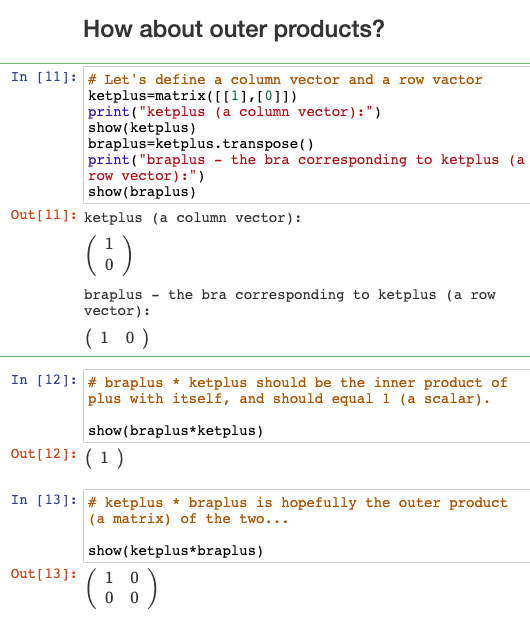
Operators and Matrices [2.2]
 Surely you've seen these speed limit signs, which reinforce their message by showing you how fast you're going...
Surely you've seen these speed limit signs, which reinforce their message by showing you how fast you're going...
A wave function ket, $\ket \psi=c_1\ket{a_1}+c_2\ket{a_2}+...$ is in general a superposition of basis states, where the amplitudes $c_1$, $c_2$, ... are complex numbers.
And yet, every physical quantity we have ever measured is a real quantity.
This implies certain constraints on the operators representing physical observables:
All QM operators representing observables must be Hermitian.
Chapter highlights so far
- Diagonalizing a matrix (operator)
- Matrices that represent the operators $\uv S_z$, $\uv S_y$, $\uv S_x$, and the new one $\uv S_{\uv n}$.
- See Hermitian adjoint (p. 44)
- "In QM all operators that correspond to physical observables are Hermitian".matrices that represent "observables" (things you can measure) must be Hermitian $\Rightarrow\mym M^\dagger = \mym M$. [p. 44]
- Wave function collapse! [p. 46]
Hermitian operators
Recall from 1.2 that the Hermitian conjugate, $\mym M^\dagger$, is the complex-congugate, transpose of a matrix $\mym M$. If $\mym M$ is a square matrix, this means $$M^\dagger_{ij}=M_{ji}^*.$$
A Hermitian matrix is one which is its own Hermitian conjugate. So $$\text{Hermitian }\Rightarrow \ \ M_{ij}=M_{ji}^*.$$ This means
- $M_{ii}=M_{ii}^*$. In other words, each diagonal element of a Hermitian matrix must be real. $$\begincv {\color{#6666ff}a} & b & c\\d & {\color{#6666ff}e} & f \\ g & h & {\color{#6666ff}k}\endcv$$
- Each off-diagonal matrix element $M_{ij}$ must be the complex conjugate of its transpose $M_{ji}$ which is diagonally opposite in the matrix. $$\begincv a & {\color{#6666ff}b} & c\\{\color{#6666ff}d} & e & f \\ g & h & k\endcv$$
Hermitian matrices have two important properties:
- The eigenvalues of a Hermitian matrix are real.
- The $n$ eigenvectors of an $n\times n$ Hermitian matrix can always be chosen to be orthogonal, (and normalized). So they form a set of basis vectors which span the $n$-dimensional space of possible quantum states.
[Notice that the eigenvectors, $\begincv 1\\1\endcv$ and $\begincv 1\\2\endcv$ of the randomly chosen matrix of our CoCalc example Eigenvectors.pdf are *not* orthogonal.]
Confirm that the matrix representations (P. 41) of all the operators we know so far, $\hat S_x$, $\hat S_y$, $\hat S_z$, and $\hat S_{\uv n}$, are Hermitian.
In operator notation...
If a ket fulfills this eigenvalue equation, written in terms of an operator, $\hat A$ instead of a matrix: $$\hat A\ket \psi = \lambda \ket \psi,$$ then $\ket \psi$ is an eigenvector of the $\hat a$ with eigenvalue $\lambda$.
See also McIntyre's equation (2.50), in which the operator $\hat A$ is *not necessarily* a Hermitian matrix.
The projection operators and Outer products
The outer product of a column vector times a row vector is a matrix... $$\mym a\otimes\mym b=\mym M.$$ Top row: $a_1\mym b$, 2nd row: $a_2\mym b$, ...
In section 2.2.3, McIntyre makes plausible some projection operators, made out of outer products: "ket-bras"!
The $\hat P_+$ operator is the outer product $\ket +\bra +$. Writing this in matrix notation, and using the definitions above to write the outer product: $$\hat P_+=\ket +\bra + \equiv \begincv 1 \\ 0 \endcv\begincv 1 & 0\endcv= \begincv 1 & 0 \\ 0 & 0\endcv.$$
Calculating outer product in CoCalc works pretty intuitively... welllll intuitively, as long as you remember to define and order your row and column vectors appropriately!

Why is this called a projection operator? Consider what happens when $\hat P_+$ operates on the state $\ket \psi=a\ket + + b\ket -\equiv \begincv a\\b \endcv$: $$\hat P_+\ket \psi = \begincv 1 & 0 \\ 0 & 0\endcv\begincv a\\b \endcv = \begincv a\\0 \endcv=a\begincv 1\\0 \endcv=a\ket +.\label{Pplus}$$
- Construct the following operators: $\hat P_-$, $\hat{P}_{+y}$, $\hat P_{-y}$.
- Show that $\hat P_+{\color{#6666ff}+}\hat P_-=\mathbb 1$, the identity matrix.
- Show that $\hat{P}_{+y}{\color{#6666ff}+}\hat {P}_{-y}=\mathbb 1$, the identity matrix.
Generally, the operator formed by adding together all the basis ket-bra's: $$\sum_{i=1}^n \ket{a_i}\bra{a_i} = \mathbb 1$$.
Wave function collapse!
For the ket $\ket\psi = a\ket + +b\ket -$, the probability that a $Z$ analyzer will measure $S_z=+\hbar/2$ is $$\P_+=|\innerp +\psi |^2=|a|^2.$$ But this can also be written in terms of the $\hat P_+=\ket +\bra +$ operator as (2.61): $$\begineq \P_+ &=|\innerp +\psi |^2\\ &=\big(\innerp +\psi \big)^*\innerp +\psi=\innerp \psi+\innerp +\psi\\ &=\bra\psi\hat P_+\ket \psi. \endeq$$
Let's revisit the transforming effect of the $\hat P_+$ operator, eq ($\ref{Pplus}$), $\hat P_+\ket \psi =a\ket +$... When $\hat P_+$ operates on some general state $\ket \psi$, we're left with the particle in the $\ket +$ state, multiplied by the amplitude $a$.
$\ket +$ is the state that emerges out of the spin-up channel of a $Z$ analyzer. It turns out that we can describe the output state of the spin up channel using details about the measurement by a $Z$ analyzer performed on some particular input state $\ket \psi$: $$\begineq \ket + &= \frac{a\ket +}{a}\\ &=\frac{\hat P_+\ket\psi}{\sqrt{|a|^2}} = \frac{\hat P_+\ket\psi}{\sqrt{|\innerp{+}{\psi}|^2}}= \frac{\hat P_+\ket\psi}{\sqrt{\P_+}}\\ &=\frac{\hat P_+\ket\psi}{\sqrt{\bra\psi \hat P_+ \ket\psi}}\\ \endeq $$
Amazing! Using just a projection operator and the input state $\ket \psi$ to a $Z$ analyzer, we can describe all these aspects of the measurement process of a $Z$ analyzer:
- Measurement transforms an initial $\ket \psi \to \ket{\psi'}$, into a possibly different final state. If $\ket{\psi'}\neq \ket{\psi}$, then the process of measurement is irreversible (unlike classical physics). The state $\ket \psi$ "collapses" into $\ket \psi'$.
- With probability $\P_+ =\bra{\psi}\hat P_+\ket\psi$, the analyzer measures $S_z=+\hbar/2$ and the final state will be $$\ket {\psi'}=\ket + = \frac{\hat P_+\ket\psi}{\sqrt{\bra\psi \hat P_+ \ket\psi}}$$
- [Similar things are known, using $\hat P_-\ket \psi$.]
Postulate 5 (p 46) generalizes these observations to measuring apparatuses that have any number of eigenstates.
The output states of a measuring apparatus are limited to the eigenvectors of the measuring apparatus that you've chosen.